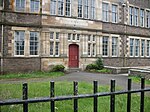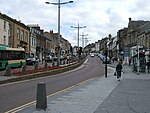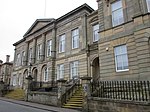St Kentigern's Church, Lanark (Hyndford Road)
Church ruins in ScotlandChurches in South LanarkshireLanarkScheduled Ancient Monuments in South LanarkshireScottish church stubs

St Kentigern's Church is a scheduled monument in Lanark, South Lanarkshire. Its churchyard and burial aisles are a category B listed building. It was previously the parish church of the town. It is believed that the church was founded by St Kentigern himself shortly before his death in 603 AD. There is documentary evidence of its existence, however, dating back to 1150 AD when King David I granted it to the monastery of Dryburgh. Pope Gregory VIII took the church into his own protection in 1228.The church, which was once attended by William Wallace, is now in a state of disrepair, despite having had repair work completed recently.
Excerpt from the Wikipedia article St Kentigern's Church, Lanark (Hyndford Road) (License: CC BY-SA 3.0, Authors, Images).St Kentigern's Church, Lanark (Hyndford Road)
A73,
Geographical coordinates (GPS) Address External links Nearby Places Show on map
Geographical coordinates (GPS)
| Latitude | Longitude |
|---|---|
| N 55.670027777778 ° | E -3.7695833333333 ° |
Address
Ruins of Church of St Kentigern's
A73
ML11 9EU
Scotland, United Kingdom
Open on Google Maps







